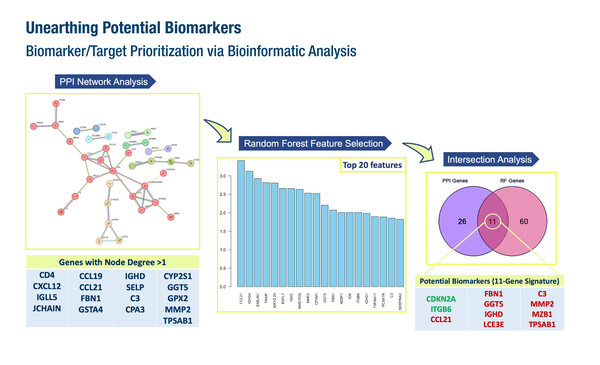Additional treatment targets and potentially repurposable agents were identified based on chemoradiotherapy response, which could now be explored for further validation.
In a study reported at the ESMO Targeted Anticancer Therapies Asia Congress 2025 (Hong Kong SAR, China, 18–20 July), transcriptomics and machine learning were used to identify the endopeptidase matrix metalloproteinase 2 (MMP2) as a new treatment-response-linked target for advanced cervical cancer (Abstract 94O). Transcriptomics data from a database of 12 patients with cervical cancer who responded to chemoradiotherapy and 9 non-responders underwent principal component analysis (PCA) and 143 differentially expressed genes were identified. Overlapping genes identified by protein-protein interaction (PPI) network analysis and a random forest model revealed an 11-gene biomarker signature that distinguished responders from non-responders.
Of the three markers of poor prognosis identified by overall survival analysis – MMP2, ITGB6 and CDKN2A – MMP2 was prioritised as the key target for drug repurposing. Subsequent screening of drug libraries based on the binding affinities to MMP2 revealed tandutinib and cabozantinib as the top hits that could potentially mimic responder gene expression patterns in non-responders.
“The ability of machine learning to integrate and scrutinise huge amounts of data to identify complex patterns is extremely powerful in the field of biomarker research,” says Dr. Raquel Perez-Lopez from the Vall d'Hebron Institute of Oncology, Barcelona, Spain. “This study serves as an example of how transcriptomics can be combined with machine learning to identify new targets in an area of considerable unmet need.” But she cautions that identification of any new target or biomarker is the start of a long journey: “A potential challenge of machine learning models is that they usually find patterns associated with whatever you are looking for. We need to be able to trust the findings and that demands a greater understanding of both the biology behind the information we are capturing and of the context in which it will be used.” Preclinical validation of MMP2 is required to confirm causality before the efficacy of potentially repurposable agents like tandutinib and cabozantinib is explored. An important point of consideration is that the identified target may be specific for the original cohort and irrelevant in a different setting. “Prospective validation in large, international cohorts is mandatory for any target or biomarker identified from small datasets,” Perez-Lopez concludes.
AI & Digital Oncology: Resources in one place
Looking for further insights into how artificial intelligence and digital tools are impacting oncology? The ESMO AI & Digital Oncology Hub brings together expert perspectives, research updates, and thought leadership from across oncology.
It is a space where you can stay informed, discover resources, and follow the conversation on digital innovation in cancer research and treatment.
To further explore the transformative potential of AI in oncology, the very first ESMO AI and Digital Oncology Congress 2025, taking place from 12 to 14 November, will provide a dedicated platform focused on the latest advances in AI and digital technologies in cancer care.







